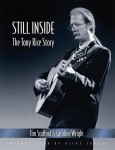 What did you do on your summer vacation? Well, I used mine to finish reading a number of books that both captured my interest, and were worthy of review on Bluegrass Today.
What did you do on your summer vacation? Well, I used mine to finish reading a number of books that both captured my interest, and were worthy of review on Bluegrass Today.
First up, let’s tackle Still Inside – The Tony Rice Story, written by Tim Stafford and Caroline Wright, and published by Word Of Mouth Press. From discussions with the publishers – and casual conversations with a good many bluegrass fans and pickers – I get the impression that this is one of those books that “everybody” has heard of, but not so many have read.
And that is a great shame. There is always the danger of appearing hubristic when declaring a book to be “important,” but I don’t see how to avoid the term. Are there many artists in our music who have had a larger impact in the past 35 years than Tony Rice? He has redefined the role of the steel-string guitar in bluegrass, both for soloing and accompaniment. His voice is among the most distinctive and influential in the history of the music, and he has found himself on the cusp of more than one major stylistic innovation.
So… why wouldn’t his authorized biography be an important statement, and a must-read addition to the library of anyone serious about bluegrass/new acoustic music – or simply fond of flatpicking guitar?
 As an unabashed fan who has followed Tony’s music since 1975, the book appealed to me immediately on that level. Before the days of the Internet and its wealth of easily-accessible information, those of us who were dedicated Rice-heads had to rely on rumor and innuendo for much of the background that wasn’t published on album covers or in Bluegrass Unlimited or Pickin’ magazine.
As an unabashed fan who has followed Tony’s music since 1975, the book appealed to me immediately on that level. Before the days of the Internet and its wealth of easily-accessible information, those of us who were dedicated Rice-heads had to rely on rumor and innuendo for much of the background that wasn’t published on album covers or in Bluegrass Unlimited or Pickin’ magazine.
Still Inside follows Tony from his youth in California, through his teen years in Florida and his entire professional career until 2009, and offers the definitive version of his life to date, both in his own words, and from dozens of friends, peers and family members.
The book tells the story in a unique format, one that advances the narrative with anecdotes and remembrances, and contains multiple appendices that future historians will reference for years to come. They include an exhaustive discography, selected bibliographical references a detailed time line of Tony’s life, and a descriptive cast of characters for folks not so deeply immersed in the music to recognize all the names.
 It divides his life into five segments, each forming a chapter in the book, and each beginning with a brief introduction, followed by Tony’s telling of that time in a very loose, conversational manner. Then, that same story is told again by people close to Tony, but in short snippets that taken as a whole, serve as an institutional memory of the time.
It divides his life into five segments, each forming a chapter in the book, and each beginning with a brief introduction, followed by Tony’s telling of that time in a very loose, conversational manner. Then, that same story is told again by people close to Tony, but in short snippets that taken as a whole, serve as an institutional memory of the time.
I’ll admit that it took me a few pages to grasp how the authors used this method to move the story along, but I caught on quickly and before long found it to be a very effective format, though a bit unorthodox by the standards of US biographical writing. Caroline Wright tells us that it is a more common style in Europe, though I don’t believe they set out to emulate that form.
Tim Stafford explained what led them to this formula:
“Some people have wondered about our approach, but it was really dictated by the subject: Tony is an amazingly complex guy, very articulate and opinionated. So we decided to let him tell his own story in his own words, with commentary from others in their own words, so the reader can decide for themselves what happened.
I really feel if we had tried to tell his story in a traditional third-person narrative biography style, it wouldn’t have been nearly as effective. The On the Road pieces may be confusing to some people, but we felt it gave even further insight into this guy who is simultaneously the greatest living acoustic guitar player, the product of an alcoholic background, a reclusive yet generous man obsessed with precision, one who was once the greatest bluegrass singer of his generation who today never cares if he sings again.
His impact in bluegrass is difficult to overestimate, but he’s all about playing music in the moment, without boundaries.
Bobby Starnes did a great job with layout, and I we’ve had some incredibly nice quotes and comments from folks across the spectrum.”
A great strength of the book comes from Tony’s openness and honesty about the trials and troubles that have plagued his life. There is no attempt to disguise his substance abuse issues, his failed marriages, difficulties with his father growing up, and the tragic losses of his son and brother, not to mention his voice. But there are many successes and highlights as well, and Still Inside succeeds marvelously in capturing such an iconic figure who has sought anonymity and privacy throughout his time in the public eye.
It is strengthened as well by the care and attention to detail of the authors, who spent several years assembling the material for the book. Stafford again…
“Caroline and I both did a series of interviews with Tony, all in person. He came down to Bristol and got a hotel room over a couple days and I did some exhaustive interviews with him. I interviewed him in hotel rooms in other places around the country where he and Blue Highway were playing. Caroline did massive interviews on a couple of different occasions when she travelled with Tony in his car and just let the tape recorder run (these were actually hard to transcribe because of engine noise).
We took all of them together and filled in the spaces with phone conversations. This probably ran to 500 pages or more. We both edited these down into his story as it appears in the book. Most of the interviews with others were done by phone, although some were in person. I also did a series of email questionnaires to get quotes and stories about Tony.
What we uncovered was amazing–the devotion this guy inspires.”
That struck me throughout the book. The admiration, affection and loyalty expressed by Tony’s friends and fellow musicians (often one and the same) is especially telling, as is his love for them – again something that doesn’t come through in his public personna.
 It covers his time with Sam Bush and Bluegrass Alliance, JD Crowe & The New South, The David Grisman Quintet, The Tony Rice Unit and the Bluegrass Album Band. All of his major recordings are discussed and remembered, as are his associations and collaborations with major figures like Béla Fleck, Jerry Garcia and Alison Krauss – often with surprising pieces of information.
It covers his time with Sam Bush and Bluegrass Alliance, JD Crowe & The New South, The David Grisman Quintet, The Tony Rice Unit and the Bluegrass Album Band. All of his major recordings are discussed and remembered, as are his associations and collaborations with major figures like Béla Fleck, Jerry Garcia and Alison Krauss – often with surprising pieces of information.
I’ll not spoil the fun by sharing any of the good bits. Suffice it to say that Still Inside is not only an “important” book, but a joyous, redemptive and fascinating story as well. Don’t deny yourself the pleasure of devouring it soon.
The book is in limited distribution at this time, but copies (including autogrphed ones) are availabe at www.tonyricestory.com.







